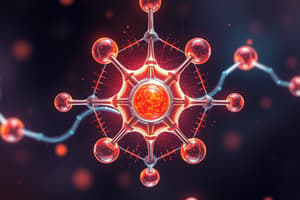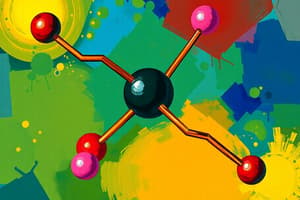Podcast
Questions and Answers
What is the resonance energy of benzene and how is it calculated?
What is the resonance energy of benzene and how is it calculated?
The resonance energy of benzene is 154 kJ mol-1, calculated by subtracting the observed enthalpy of hydrogenation (-209 kJ mol-1) from the expected value (-363 kJ mol-1).
What hybridization do the carbon atoms in benzene undergo and what is the bond angle?
What hybridization do the carbon atoms in benzene undergo and what is the bond angle?
The carbon atoms in benzene undergo sp2 hybridization and the bond angle is 120 degrees.
Describe the structure of the π molecular orbitals in benzene according to Molecular Orbital theory.
Describe the structure of the π molecular orbitals in benzene according to Molecular Orbital theory.
In benzene, the six overlapping p-orbitals combine to form six π molecular orbitals, with three bonding orbitals of lower energy and three antibonding orbitals of higher energy.
What bond length is characteristic of benzene, and how does it compare to single and double bonds?
What bond length is characteristic of benzene, and how does it compare to single and double bonds?
Signup and view all the answers
How does the resonance hybrid of benzene compare to its canonical forms in terms of stability?
How does the resonance hybrid of benzene compare to its canonical forms in terms of stability?
Signup and view all the answers
What is the significance of the bond lengths and angles in understanding benzene's molecular structure?
What is the significance of the bond lengths and angles in understanding benzene's molecular structure?
Signup and view all the answers
What happens to the pz electrons in benzene, and how do they contribute to the molecular structure?
What happens to the pz electrons in benzene, and how do they contribute to the molecular structure?
Signup and view all the answers
Explain the concept of degenerate orbitals in the context of benzene's molecular orbital theory.
Explain the concept of degenerate orbitals in the context of benzene's molecular orbital theory.
Signup and view all the answers
What is the key criterion for a compound to be classified as aromatic according to Hückel's rule?
What is the key criterion for a compound to be classified as aromatic according to Hückel's rule?
Signup and view all the answers
List two examples of aromatic compounds that belong to the category of heterocycles.
List two examples of aromatic compounds that belong to the category of heterocycles.
Signup and view all the answers
Describe the structure of benzene as proposed by August Kekulé.
Describe the structure of benzene as proposed by August Kekulé.
Signup and view all the answers
What limitation does Kekulé's structure have regarding the prediction of 1,2-dibromobenzene isomers?
What limitation does Kekulé's structure have regarding the prediction of 1,2-dibromobenzene isomers?
Signup and view all the answers
What is a resonance hybrid in the context of benzene?
What is a resonance hybrid in the context of benzene?
Signup and view all the answers
Identify the type of aromatic compound represented by naphthalene.
Identify the type of aromatic compound represented by naphthalene.
Signup and view all the answers
What spatial arrangement do all aromatic rings possess?
What spatial arrangement do all aromatic rings possess?
Signup and view all the answers
Can a compound with 4 π electrons be categorized as aromatic? Explain.
Can a compound with 4 π electrons be categorized as aromatic? Explain.
Signup and view all the answers
What distinguishes benzene from cyclohexene in terms of chemical reactions?
What distinguishes benzene from cyclohexene in terms of chemical reactions?
Signup and view all the answers
Explain why naphthalene is considered an aromatic compound.
Explain why naphthalene is considered an aromatic compound.
Signup and view all the answers
How many π-electrons are contributed by the 7 double bonds in a molecular structure?
How many π-electrons are contributed by the 7 double bonds in a molecular structure?
Signup and view all the answers
What is the result of the reaction of cyclohexene with KMnO₄?
What is the result of the reaction of cyclohexene with KMnO₄?
Signup and view all the answers
State one key factor that contributes to the stability of benzene.
State one key factor that contributes to the stability of benzene.
Signup and view all the answers
What is Hückel's rule, and how does it define aromatic compounds?
What is Hückel's rule, and how does it define aromatic compounds?
Signup and view all the answers
What are the key limitations of Kekulé's structure of benzene?
What are the key limitations of Kekulé's structure of benzene?
Signup and view all the answers
Compare the stability of benzene to that of cyclohexene.
Compare the stability of benzene to that of cyclohexene.
Signup and view all the answers
What historical significance did Michael Faraday have in the study of aromatic compounds?
What historical significance did Michael Faraday have in the study of aromatic compounds?
Signup and view all the answers
What role does resonance theory play in understanding benzene's structure?
What role does resonance theory play in understanding benzene's structure?
Signup and view all the answers
List at least two pharmaceutically important aromatic compounds and their uses.
List at least two pharmaceutically important aromatic compounds and their uses.
Signup and view all the answers
What is the significance of the six-carbon unit noted by August Kekulé in aromatic compounds?
What is the significance of the six-carbon unit noted by August Kekulé in aromatic compounds?
Signup and view all the answers
How does molecular orbital theory provide insight into benzene’s stability?
How does molecular orbital theory provide insight into benzene’s stability?
Signup and view all the answers
Study Notes
Pharmaceutical Chemistry - Aromatic Compounds
- Lecture 1: Covers the chemistry of aromatic compounds
-
Recommended Reading:
- Organic Chemistry by Clayden, Greeves, Warren, and Wothers
- Organic Chemistry by Loudon
- Organic Chemistry by G Solomon & C Fryhle
- General chemistry and organic chemistry textbooks also cover aromatic chemistry
-
Lecture 1 - Content:
- History and importance of organic compounds
- Definition of aromatic compounds (Hückel's rule)
- Classification of aromatic compounds
- Kekulé's structure of benzene and its limitations
- Resonance theory of benzene
- Molecular Orbital theory of benzene
- Comparison between cyclohexene and benzene
-
Introduction:
- Many drugs are aromatic derivatives or contain an aromatic moiety
-
Pharmaceutically Important Aromatics: Several example structures and their uses/functions are shown, including:
- Aspirin: An analgesic and antipyretic
- Morphine: A narcotic analgesic
- Valium: A tranquilliser
- Sulfamethoxazole: An antimicrobial agent
-
Historical Background (Aromatic compounds):
- 1826: Michael Faraday discovered benzene and named it "bicarburet of hydrogen"
- 1834: Eilhardt Mitscherlich synthesized benzene
- 1865: August Kekulé noted all early aromatic compounds contained a six-carbon unit.
-
Definition: Aromaticity Criteria:
- Aromatic compounds have one or more rings with a cyclic arrangement of p orbitals.
- Every atom in an aromatic ring has a p orbital
- Aromatic rings are planar
- An aromatic ring has 4n + 2 π electrons (where n = 0, 1, 2,...)
-
Classification:
- Benzene and its monocyclic derivatives (toluene)
- Polycyclic benzenoids (naphthalene)
- Non-benzenoids (azulene)
- Macrocyclic (e.g., [14]annulene)
- Heterocyclic (e.g., pyridine, pyrrole)
-
Kekulé's Structure of Benzene:
- Six carbon atoms in a ring
- Alternating single and double bonds between carbon atoms
- One hydrogen atom attached to each carbon atom
- All carbon and hydrogen atoms are equivalent
-
Limitations of Kekulé's Structure:
- Kekulé's structure predicts two 1,2-dibromobenzenes, but only one is observed.
- Kekulé proposed equilibrium between two forms, but this was later proven incorrect.
- One form is not preferred, therefore, it is not in equilibrium.
-
Resonance Theory Applied to Benzene:
- Benzene's true structure is a resonance hybrid between Kekulé forms.
- Different contributing structures = canonical forms
- Resonance hybrid is more stable than any canonical form.
- Resonance energy or delocalization energy is the difference in energy between the hybrid and most stable form.
-
Molecular Orbital (MO) Theory for Benzene:
- Bond angle is 120° (sp² hybridization)
- Bond length is intermediate between single and double bonds (1.39 Å)
- Each carbon atom has 1 σ bond to hydrogen, and 2 σ bonds to other carbon atoms. 1 unhybridized p orbital remains for each carbon atom.
- The p electrons from each carbon atom overlap above and below the plane of the molecule.
- Six π molecular orbitals are formed from the six overlapping p orbitals.
- Three bonding orbitals, three anti-bonding orbitals
- The bonding orbitals are lower in energy than the isolated p orbitals. The anti-bonding orbitals are higher in energy.
-
Comparison of Cyclohexene with Benzene:
- Cyclohexene is an alkene, non-aromatic, undergoes electrophilic addition reactions
- Benzene is aromatic, undergoes electrophilic substitution reactions
-
Worked Examples:
- Aromatic compound identification (e.g., naphthalene)
- π-electron counting in a molecule (e.g., 14 π-electrons)
Studying That Suits You
Use AI to generate personalized quizzes and flashcards to suit your learning preferences.
Related Documents
Description
Test your knowledge on the structure, hybridization, and resonance energy of benzene. The quiz covers key concepts like molecular orbitals, bond length, and Hückel's rule. Ideal for chemistry students looking to deepen their understanding of aromatic compounds.




